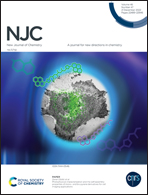The mechanism of [3+2] annulations between indole-2-formaldehydes and isatins mediated by N-hetrocyclic carbenes: a DFT study†
Abstract
We present a comprehensive DFT study of the mechanism for N-heterocyclic carbene (NHC)-catalyzed cycloaddition that uses indole-2-formaldehydes and isatins as substrates. After precatalyst activation, the catalytic reaction proceeds through six steps: initial coupling of NHCs with indole-2-formaldehydes, followed by 1,2-proton transfer. Then the resulting Breslow intermediate undergoes successive oxidization (by quinone DQ), N–H deprotonation, and [3+2] cycloaddition. The five-membered cycloadduct further undergoes NHC elimination to form the final product. For Breslow intermediate formation, besides the direct mechanism, the use of mediators (NEt3 and NEt3·H+) to promote proton transfer has been examined, and the energetically most preferred pathway is that promoted by the Brønsted acid NEt3·H+. The [3+2] cycloaddition determines the stereochemistry arising mainly from a combination of weak interactions (CH⋯O and lone pair (LP)⋯π) and produces (S)-N,O-aminal indole predominantly. Our DFT results align with previous experimental observations. The present study may provide some useful hints for the rational design of more stereoselective reactions and even the selection of catalysts and substrates.
![Graphical abstract: The mechanism of [3+2] annulations between indole-2-formaldehydes and isatins mediated by N-hetrocyclic carbenes: a DFT study](/en/Image/Get?imageInfo.ImageType=GA&imageInfo.ImageIdentifier.ManuscriptID=D2NJ04442K&imageInfo.ImageIdentifier.Year=2022)


 Please wait while we load your content...
Please wait while we load your content...